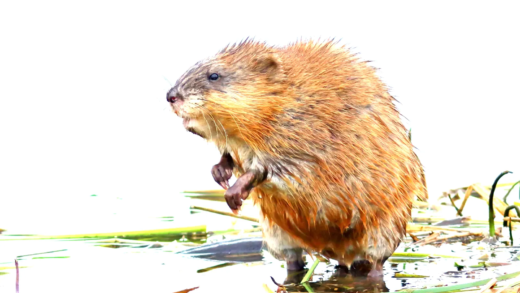White squirrels, particularly leucistic ones, are a rare and fascinating sight in Brevard, North Carolina. Their unique genetic traits distinguish them from albino squirrels, contributing to local myths and legends. The thriving population in Brevard can be attributed to conservation efforts and environmental adaptations. These squirrels impact the ecosystem positively through seed dispersal and attract tourism, boosting the local economy. Spotting tips include visiting parks and being patient during peak activity times.
What are White Squirrels?
White squirrels are a fascinating variation of the common gray squirrel, scientifically known as Sciurus carolinensis. These unique creatures are not completely albino; instead, they are classified as leucistic squirrels. This means they possess a genetic mutation that reduces pigmentation, resulting in their striking white fur. Unlike albino squirrels, which have pink eyes and lack any pigmentation, leucistic squirrels often have darker eyes and a more varied coloration in their fur, sometimes with hints of gray or brown.
In Brevard, North Carolina, white squirrels are particularly well-known. They have become a symbol of the area, drawing visitors eager to catch a glimpse of these rare animals. The population here is thriving, primarily due to the local conservation efforts that provide a suitable habitat for these squirrels. Their charm and rarity make them a subject of local folklore and community pride.
Leucistic vs. Albino Squirrels: What’s the Difference?
The distinction between leucistic and albino squirrels is critical for understanding their biology. While both types exhibit reduced pigmentation, the differences lie in their physical features and genetic makeup. Albino squirrels have a complete absence of melanin, leading to their characteristic white fur and pink eyes. On the other hand, leucistic squirrels retain some pigment, which results in white fur but with darker eyes, typically brown or black.
Another interesting aspect is the survival rates of these two types. Albino squirrels are more vulnerable to predators due to their lack of camouflage. Their white fur stands out against natural backdrops, making them easier targets. In contrast, leucistic squirrels, with their slightly darker features, blend in better with their surroundings, giving them a slight edge in survival.
Why Are Leucistic Squirrels So Rare?
Leucistic squirrels are rare due to the specific genetic mutation required to produce their unique coloration. This mutation is not common in the wild, making their population limited. In fact, the occurrence of leucism in squirrels is estimated to be about 1 in 100,000. This rarity is compounded by environmental factors, such as habitat loss and predation, which can impact their survival rates.
In addition, the genetic diversity within the squirrel population affects the likelihood of leucistic offspring being born. With fewer breeding pairs carrying the leucistic gene, the chances of producing more leucistic squirrels decrease. This makes the white squirrels of Brevard even more special, as they represent a small but thriving population within their natural habitat.
Brevard, North Carolina: Where Is It?
Brevard is a charming town located in Transylvania County, North Carolina. Nestled in the heart of the Appalachian Mountains, it serves as a gateway to the breathtaking Pisgah National Forest. This picturesque area is known for its stunning landscapes, including rolling hills, lush forests, and numerous waterfalls. Brevard has gained popularity not only for its natural beauty but also for its vibrant arts scene and outdoor activities.
As a hub for adventure enthusiasts, visitors can explore hiking trails, mountain biking routes, and fishing spots nearby. The town’s elevation of approximately 2,200 feet provides a perfect climate for various flora and fauna, including the famous white squirrels. Its quaint downtown area features local shops, restaurants, and galleries, making Brevard a delightful destination for travelers seeking both relaxation and adventure.
The Thriving White Squirrel Population in Brevard
The white squirrel population in Brevard is thriving, largely due to a combination of favorable environmental conditions and community efforts. Residents take pride in their unique white squirrels, which have become a symbol of the town. Several factors contribute to the abundance of these leucistic squirrels:
- Conservation Efforts: Local conservation initiatives focus on protecting the habitat of white squirrels, ensuring they have ample resources for survival.
- Natural Environment: Brevard’s diverse ecosystem offers food sources and shelter, allowing white squirrels to thrive in a safe environment.
- Community Awareness: The town actively promotes awareness about white squirrels, encouraging residents and visitors to appreciate and protect them.
This combination of factors has led to a growing population of white squirrels, making them a common sight in parks and neighborhoods. For visitors, spotting these rare creatures has become a delightful experience, adding to the allure of Brevard.
The History of White Squirrels in Transylvania County
The history of white squirrels in Transylvania County is rich and fascinating. The presence of leucistic squirrels in the region dates back to the early 20th century. Local folklore suggests that the first sightings of white squirrels occurred around the 1940s, capturing the imagination of residents and visitors alike. As the story goes, a few white squirrels were introduced to the area, and they quickly adapted to their new environment.
Over the years, these unique creatures have become a point of pride for the community. Annual festivals, such as the White Squirrel Festival, celebrate their significance, bringing together locals and tourists for festivities that include arts, crafts, and live music. This event not only showcases the town’s love for white squirrels but also promotes the importance of wildlife conservation. The enduring fascination with these squirrels continues to shape the cultural identity of Brevard, making them a beloved part of local heritage.
Myths and Legends Surrounding White Squirrels
White squirrels have inspired numerous myths and legends throughout history, particularly in regions where they are prevalent, such as Brevard. One popular tale suggests that spotting a white squirrel brings good luck. Many locals believe that if you see one, it signifies a positive change or a stroke of fortune in your life. This belief has led to the creation of various community events and festivals centered around these charming creatures.
Another fascinating legend involves the idea that white squirrels are the spirits of ancestors watching over the community. This notion adds a layer of cultural significance to the presence of white squirrels in Brevard, intertwining them with local identity and heritage. As such, these myths not only enrich the community’s folklore but also foster a sense of pride and connection among residents.
How Do White Squirrels Adapt to Their Environment?
White squirrels, like their gray counterparts, have developed several adaptations that allow them to thrive in their environment. Their leucistic condition provides them with a unique camouflage, especially in snowy or light-colored surroundings, which can aid in evading predators. Additionally, these squirrels have learned to utilize the diverse habitats of Brevard, taking advantage of the abundant food sources available.
White squirrels are also known for their resourcefulness. They often forage for nuts, seeds, and fruits, which are plentiful in the region’s lush forests. Their ability to adapt their foraging techniques to seasonal changes ensures their survival throughout the year. Moreover, community efforts to maintain and protect their habitats have created a favorable environment, allowing these squirrels to flourish.
The Impact of White Squirrels on the Local Ecosystem
The presence of white squirrels in Brevard has a noticeable impact on the local ecosystem. As foragers, they play a crucial role in seed dispersal, aiding in the growth of various plant species. This natural process contributes to the biodiversity of the area, promoting a healthy ecosystem. Additionally, their interactions with other wildlife can influence the population dynamics of different species, creating a balanced environment.
Furthermore, the white squirrel population attracts tourists and nature enthusiasts, which can benefit local businesses. This economic boost encourages conservation efforts, leading to better habitat management and protection for not just white squirrels but all wildlife in the region. Therefore, the impact of white squirrels extends beyond their biological role, influencing both ecological balance and community development.
Tips for Spotting White Squirrels in Brevard
For those eager to catch a glimpse of white squirrels in Brevard, here are some helpful tips:
- Visit Parks and Nature Reserves: Locations like Pisgah National Forest are prime spots for white squirrel sightings.
- Look During Early Morning or Late Afternoon: White squirrels are most active during these times, increasing your chances of spotting them.
- Be Patient and Quiet: Approaching quietly can help avoid startling these skittish creatures.
- Bring Binoculars: These can help you spot white squirrels in trees or at a distance.
- Join Local Tours: Participating in guided nature tours can provide insights and increase your chances of seeing these unique squirrels.
By following these tips, visitors can enhance their experience and enjoy the charm of Brevard’s white squirrels.





Comments are closed.